Ben Meadowcroft’s daughter, Annie married Herbert Halstead, the nephew of Handel Halstead. I found that Ben made his living as an innkeeper keeping one of the pubs in Hebden Bridge, close to my home.
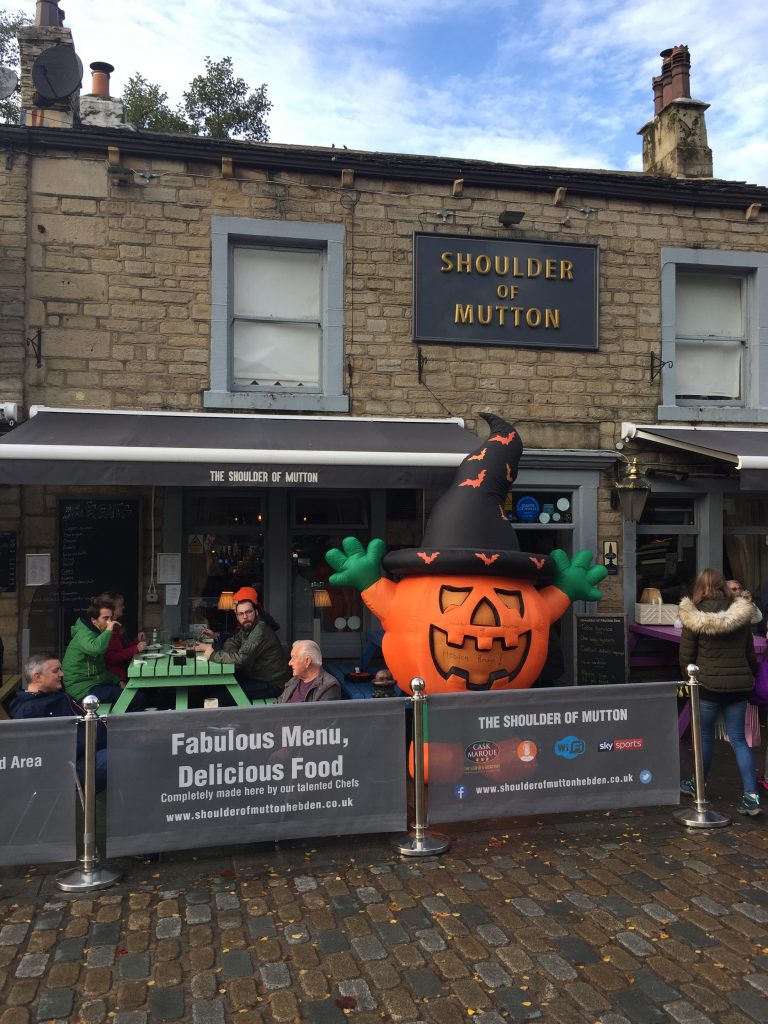
The Shoulder of Mutton is in the very centre of Hebden Bridge. In fact I often think of it as ‘being the centre of Hebden Bridge.’ Spanning one entire side of St George’s square it’s where the tourists throng on summer afternoons, its outside tables bedecked in men minus their shirt but plus their beer guts, seemingly attempting to catch so much sun as to appear lobster red so that they can show their workmates on Monday morning what a good time they’ve had over the weekend.
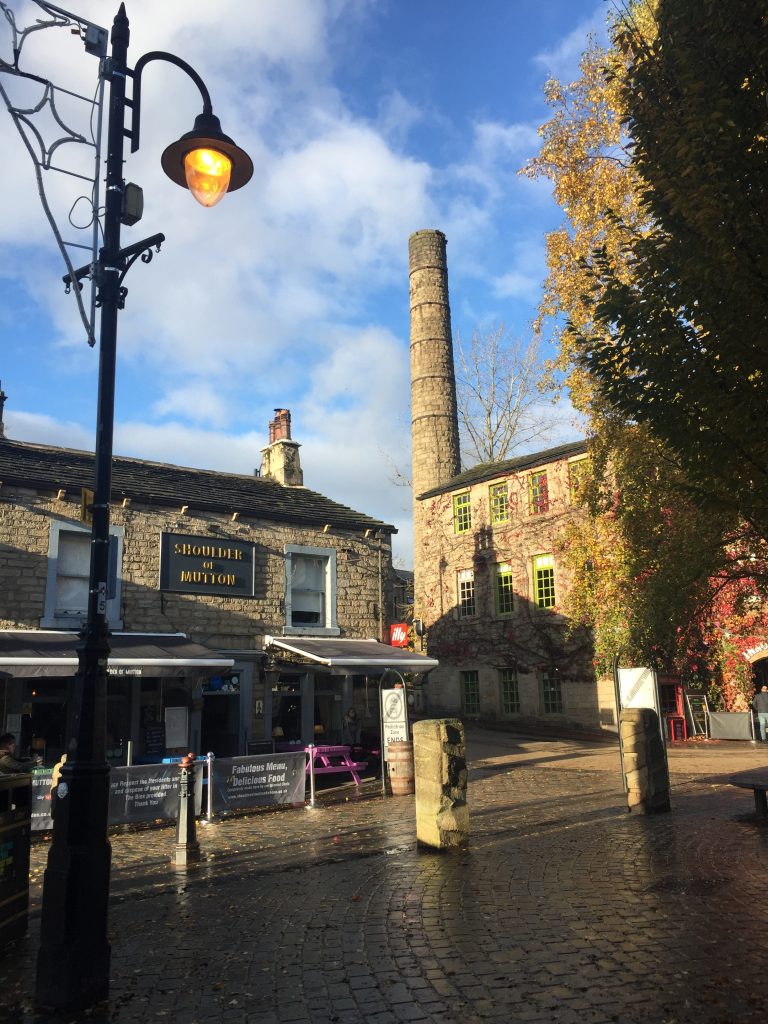
In 2017 Sarah and I had spent a great couple of weeks in Hebden, staying at Thorn Bank, which, unbeknownst to us at the time, had been a boarding school that our Moss ancestors used to run. After two weeks Sarah was flying back to the US and I was staying on for a few more weeks by myself. My journal of that trip reads: The weather matched out mood as Sarah began packing for her journey home. Sarah was so sad about leaving England and I was anxious about how I was going to deal with being alone in England for 8 weeks. (It seems strange to be copying that sentence in November after making the decision to move to England). We had lots of clean up to do at Thorn Bank so I suggested we got it done and then wander into Hebden Bridge for a final drink. It was still raining hard and we were unsure which pub to go in but after passing a few and looking in the windows we decided on The Shoulder of Mutton where we’d gone on our first night. Then it had been packed and there had been standing room only. Now there were only a couple of tables in use and by the time we left at 10 p.m. we were the only ones left. Talk about a lack of atmosphere – and what a contrast to Saturday night. Where was everybody tonight? ”
I’ve only been in a couple of times since then but now that I know that one of our ancestors was the landlord in 1901 until his death 3 years later I need to pay another visit.
But before that off I went – metaphorically speaking – into Ben’s life story. I found myself learning about the local sport of knur and spell in which Ben excelled and locating the location of a now demolished pub in Luddendenfoot with the unusual name of the Chatburn and Jennings but was locally known as ‘The Bug Trap.’ I even managed to find a photo of his brother, Spencer, online.
Born in 1858 to Reuben, an outdoor labourer, and his wife Hannah, Ben was the 9th out of 10 children. The family had been living at Thorpe House for at least 7 years by the time Ben was born. I wondered if he got his name as a shortened form of Reuben. One interesting fact that I had at first overlooked was that Hannah’s maiden name was Thorpe and . . . . they named one of their children Thorpe. Could it have been a coincidence that they lived at Thorpe House? I needed to find out more about their home. In 1851 there were 4 families living in Thorpe House on Hand Carr Lane above Luddenden. Reuben was an outdoor labourer, and his sons were a joiner, a mason’s labourer, a labourer in a cotton mill, and the rest were cotton weavers and worsted spinners – all manual jobs. Living next door in Thorpe House were the Crowther family – and, oh my goodness the head of the family was called Thorp Crowther (who ‘declined work’). His son, also called Thorp was a worsted weaver! What is this Thorp thing going on here? Next door to them was a stone mason and his family and lastly a farmer of 8 acres who was also a stone mason. So altogether there were 28 people living in Thorpe House in 1851. In 1988 it became a listed building though unfortunately there are no photographs of the property in the listing. Searching further I found that the property is now Willow Royd Stables and Equestrian centre which recently came up for sale at just over one million pounds.

Ben Meadowcroft married Mary Nicholl at Halifax minster in 1878. He was 20 and she was 19. The couple set up home at Middle Hathershelf above Scout Road. I looked up the location on Google Earth. Even today the lane is barely wide enough for a car to travel along. It’s in a very exposed position with amazing views over the Calder valley on the same side of the valley as Sowerby. And then I remembered something! I’ve walked down that very lane. I quickly pulled out my Ordinance survey map on which I mark routes that I have hiked and yes, Hathershelf Lane was marked in pink. (Thank you, Sarah, for the set of marker pens).
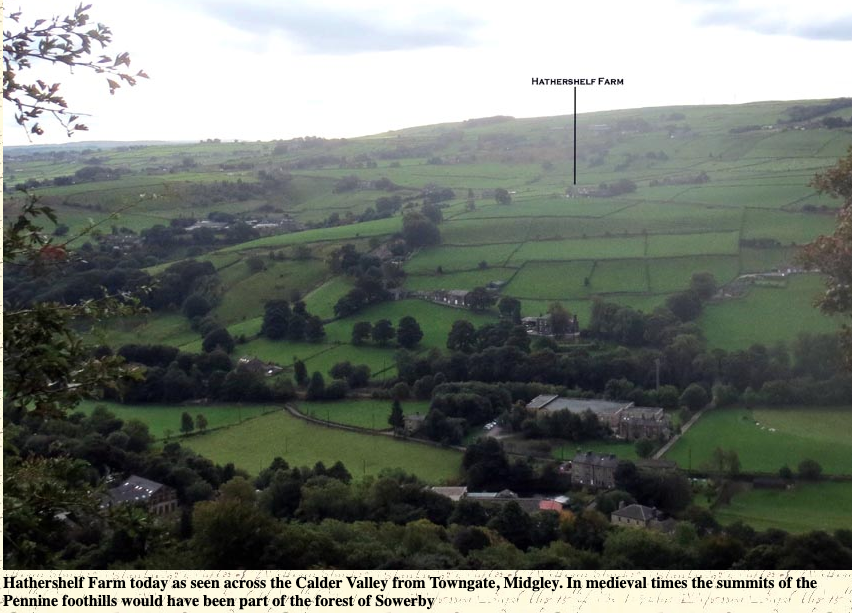
I found the location of Middle Hathershelf farm on an 1851 map. Something was still ringing a bell inside my head, so I check my photos to see when I’d walked down that lane. The answer – November 18, 2019 and yes, you’ve guessed it – I’d taken a photo of a very picturesque ancient farmhouse that was – – – Middle Hathershelf farm.

Ben was making his living as an engine tenter, stretching out woollen cloths to dry using a machine in a mill. I wonder which mill. His house was 600ft above the valley floor where I presume the nearest mill would have been at Luddendenfoot.
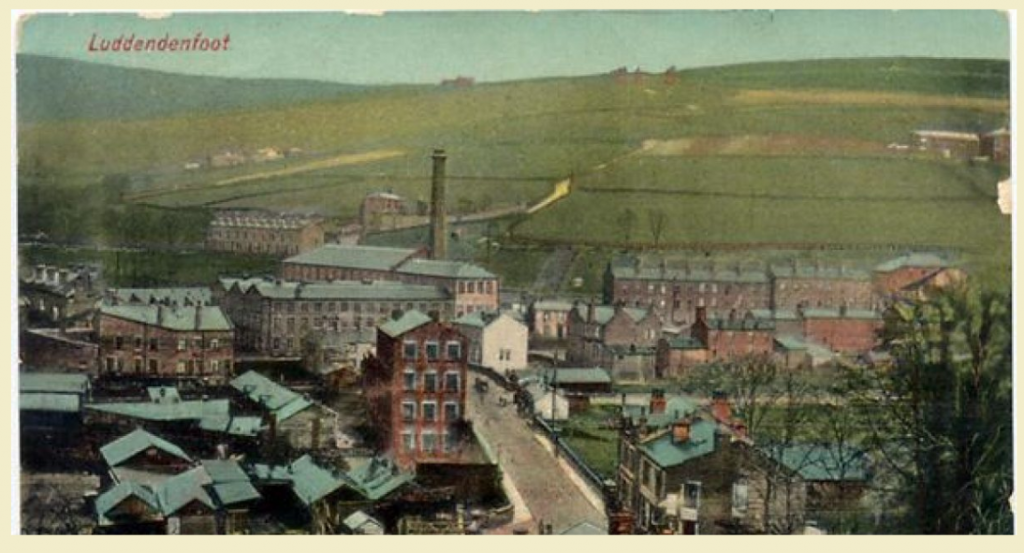
But by 1885 the family had migrated into the valley bottom and Ben had taken up a new occupation. He was the landlord at the now demolished Chatburn and Jennings Hotel. The inn had received its license in 1861 and closed in 1923 due to ‘redundancy.’
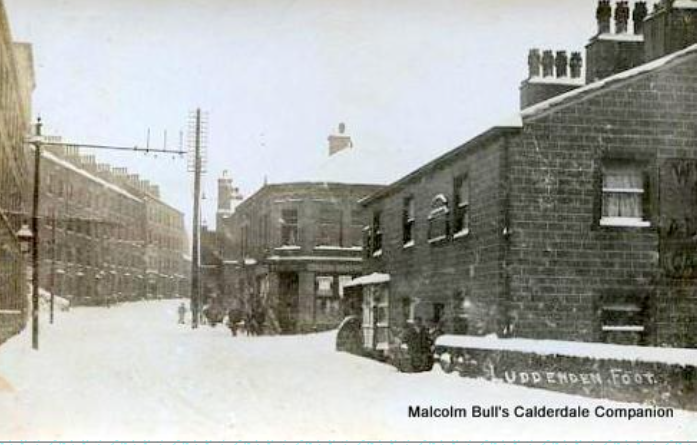
Wow! What a name for a pub. I read in a newspaper article that the name had come about because of a family dispute between the two families but by the locals it was known as The Bug Trap. As Stephen Gee writes in his Halifax Pubs book about The Bug Trap ‘and we’ve all known a few of them.’ For me it brought back memories of a trip to Romania when Ceaușescu was still in power, and being eaten alive by bed bugs in the hostel I was staying in. Ben’s pub, however, was situated not in an Eastern European country but on the corner of Station Road and Burnley Road in West Yorkshire but was closed due to ‘redundancy’ in 1923 and public toilets were built on the site. I’ve spent many hours waiting for a bus at this junction, little knowing of my connection with its past residents.
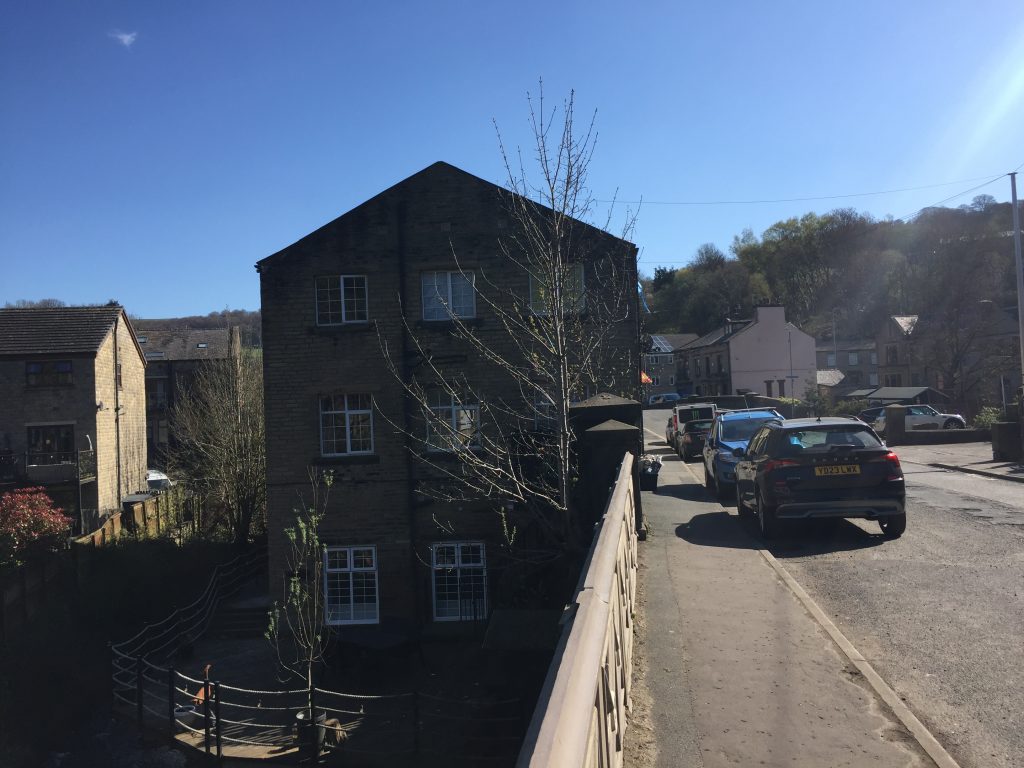
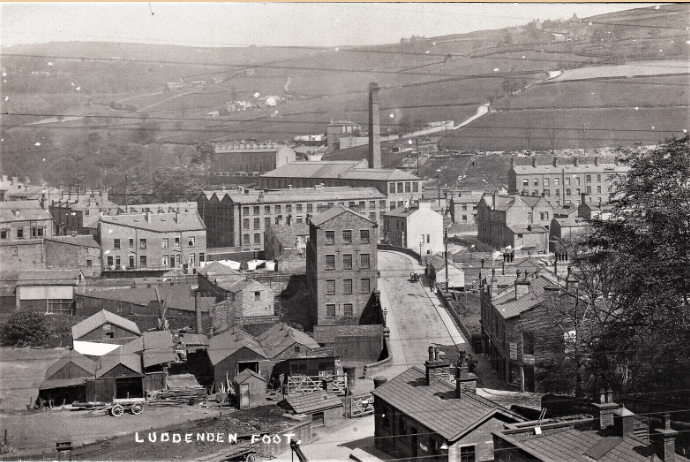
10 years later Ben was still running the pub, his 12 year old daughter, Annie, already being employed in the mill as a worsted operative. By then his daughters Lizzie and Beatrice were aged 5 and 3.
By 1899, however, I found the family installed in the Shoulder of Mutton in the centre of Hebden Bridge, where I started out my story. When Ben died in 1904 at the age of 46 it appears that Mary was missing the ‘high life’ and she moved back to the hill tops, this time to the South side of the Calder Valley and she took over the running of The Lord Nelson at Midgley (license transferred Oct 6, 1905 from B. Bailey) 1905, 1908 Malcolm Bull). The pub opened as the Black Rock inn in 1755 and changed its name to The Lord Nelson after the battle of Trafalgar according to Halifaxpeople.com. Other sites state that the Black Rock was actually housed in the cottages close to the current Lord Nelson which have since been demolished. The elevated position of the pub made it a favourite with walking groups and in 1884 it featured in a ramble of the Cragg Vale botanical society as they explored the flora of Hill House Clough (Hill House being the scene of the murder/suicide of another of my ancestors). After a pleasant tea in the pub the men displayed their specimens on a table and a man from Littleborough named them. In 1887 the Lord Nelson was in the news again for a much more gruesome reason. A young woman from the village, Sarah Ann Shackleton aged 23, had been seen making her way to the outdoor privy. A neighbour asked her “Art thou poorly” and she replied that she had a bowel complaint. A few minutes later the neighbour saw her going up the cobbled lane back to her house, holding on to the wall for support. She then appeared to drop something and hastily put it under her shawl. A few steps later she stumbled again and was seen holding onto the wall for support before she fainted. Two days later a doctor was called to her home on Towngate, Midgley, where she lived with her father. At first she denied having given birth to a baby but finally she admitted that she had, and that she had buried the baby on the moor. Constable, P. C Person was called and Sarah Ann told him exactly where she had buried the baby. A search was made and the baby was found buried on the moor, 2 miles above the village. The baby girl taken to the Lord Nelson inn where a doctor carried out an autopsy. Sarah Ann was sent for trial at the York assizes.
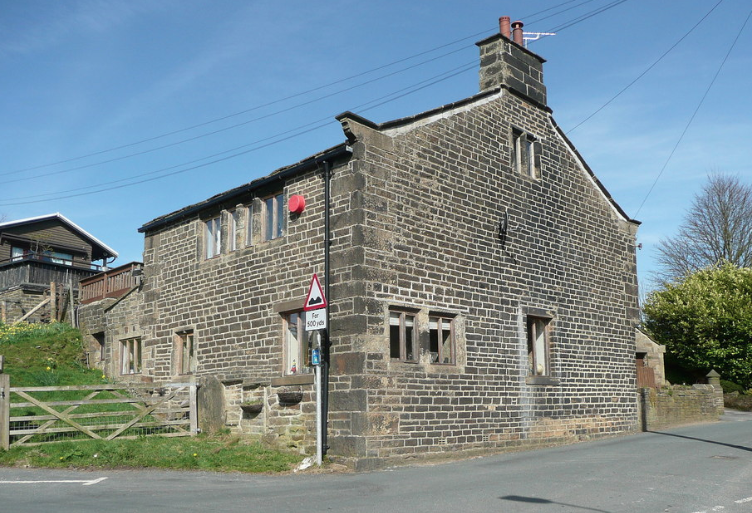
The former Lord Nelson is now a private residence. The left hand side of the building has been demolished at some stage. 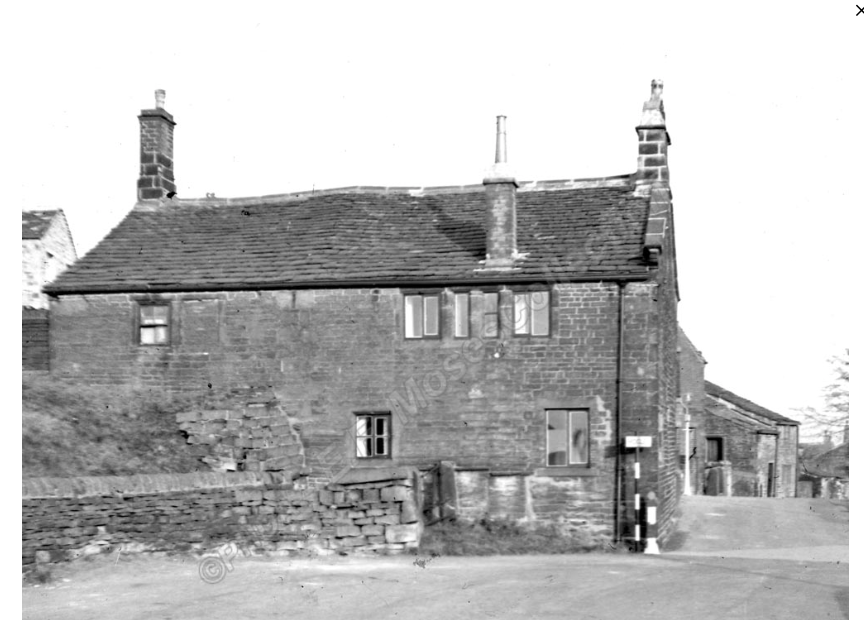
From Pennine Horizons Digital Archive (no date).
No longer a pub but a private residence I passed it last week as I went to watch a performance by the Midgley Pace Eggers – again, unaware of my connection with its former residents. Mary was the licensee in 1905 and 1908. The pub closed as an Inn for good on 27th December 1932. (information from Malcolm Bull’s Calderdale Companion). In July 1908 Mary left the Lord Nelson and moved back to the Chatburn and Jennings. 1911 finds Mary and daughters Lizzie and Beatrice there. Rather unusually those two daughters, now aged 25 and 23 were still unmarried. Annie had married Herbert Halstead.
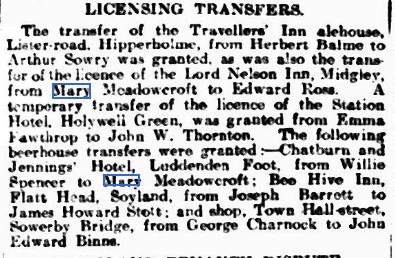
Mary was still running the pub in 1922.
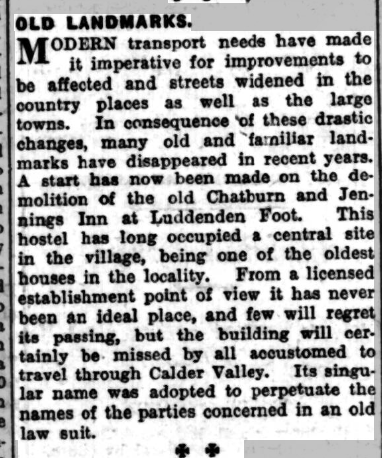
However, in May 1923 it was clear that its days were numbered. Members of Luddenden Foot district council toured the highways and byways of the district to the accompaniment of sunshine and showers.
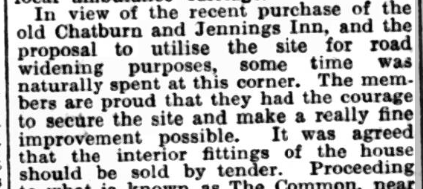
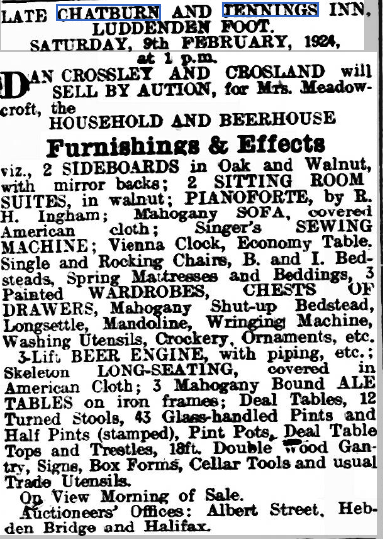
So Mary was forced to sell the furnishings and effects from the inn and her home. So far I’ve been unable to find out where she moved to. But what could I discover about what these ancestors liked to did in their spare time? I turned to my main source – the local newspapers of the day. Somehow it didn’t surprise me that Ben’s first mention in the newspaper was drink related. I’ve seen this in so many of my ancestors, especially those who were running pubs. Take Paul Taylor for example, who was running the Fox and Goose in Hebden Bridge. In 1875, aged 17, he was charged with allowing drinking on his premises after hours and also gambling on the Lord’s day. The following year Paul’s brother John, landlord of the Stubbing Wharf was charged with being drunk in his own establishment. In 1882 ‘two men were charged with being drunk whilst being in charge of a horse and trap in Hebden Bridge. Ben Meadowcroft of Brearley was charged with drunkenness at the same time and place. The evidence of P.C. Smith went to show that at about 7 o’clock on the evening named, he saw the defendants and four others driving furiously down Bridge-lanes. He signalled to them to stop, but one of the party called out–” Drive over the b—r.” He caught hold of the trap behind, and jumped on, and after some trouble got the defendants’ names. The defendants were all drunk. Midgley and Fielding drove.–Paul Taylor, beerseller, Newgate-end, was called by the police to prove that two of the defendants were so drunk that he refused to serve them immediately before they encountered the police. Fielding was, however, not so drunk, and was served. Several witnesses were called for the defendants, who positively swore that when they arrived home about 7.30, they were not drunk.—P.S. Eastwood stated that the defendants’ party drove through Hebden Bridge at about 3 p.m., and again in the evening on the 19th ult., one of the party playing a concertina, and others singing.–Midgley was ordered to pay a fine of 20/- and the costs 11/9; Fielding a fine of 20/- and costs 9/6 ; and Meadowcroft a fine of and costs 9/6.’
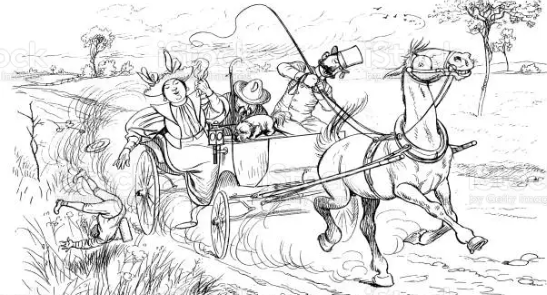
I find it pretty amazing that it was Paul Taylor who had refused to serve them. I wonder which one of the people charged was playing the concertina!
In 1898 Ben did not appear at Todmorden petty sessions to defend himself on a charge of allowing his dog to roam the streets unmuzzled from his home at the Shoulder of Mutton. He was fined 2/6 and 7/6 costs.
But Ben features in the newspaper in 1886 for more positive reasons too.
KNUR AND SPELL for £50.—There were quite two thousand persons assembled Halifax Racecourse on Saturday, when Ben. Meadowcroft of Luddenden Foot and Fred. Moore of Halifax, met to contest the best of 30 rises each, level, with wood knurs, for £25 a side. Speculation was of a heavy character, closing at 30 to 20 on Moore. At the first five rises each man registered 51 score, but from this point Moore gradually forged ahead.

Ben was more successful however at a Knur and Spell competition in Wakefield that was recounted in the Yorkshire Post in 1893.’KNUR AND SPELL CONTEST AT WAKEFIELD.— There was a very large attendance at the City Grounds, Wakefield, Saturday afternoon. The men engaged were Ben Meadowcroft, of Luddendenfoot, and Harold Dyson, Huddersfield, who agreed to play 30 rises each, with wood heads and knurs for £5O a side. Betting ruled 25 Meadowcroft. Dyson opened very badly, having a miss at the third rise, and the first five rises gave the favourite a lead score, which was increased score after half-time. Meadowcroft played regular stroke, whilst Dyson was very uneven, and was badly beaten by 22 score, the totals being Meadowcroft 287, Dyson 265.
Two years later in 1895 we read that On Saturday a match was played on the grounds of the Lightcliffe Gun Club, between Ben Meadowcroft. of Luddenden-foot, and Fred Moore, Kavensthorpe, for £25 side. Meadowcroft was the winner by 18 score.
But what on earth IS this game? I mean £5O was a year’s wages at the time. I’d never heard of it until I moved here and read about a Knur and Spell ground in the Popples area of Heptonstall. The principle of the game was to strike a small hard ball called the knur. The knur was either thrown up or suspended in a loop of cord, with a specially constructed stick called the spell. The aim was to drive the ball as far as possible. Shots of up to 300 yards have been recorded. The match was decided by the longest knock, or the best average in an agreed number of knocks. The course was marked with vertical pegs at intervals of 20 yards to facilitate measurements, which were taken over walls, huts or other obstructions. Matches were normally between twenty and thirty knocks, with each player taking five consecutive shots in turn. A referee supervised the contest and the rules were observed rigidly. The game was often called “poor man’s golf” and was a popular pub sport in West Yorkshire, especially in the Calder Valley.
To watch a knur and spell that took place in 2015 watch: https://www.youtube.com/watch?v=XfNV6ChcMtw
A game in 1932: https://www.youtube.com/watch?v=0KH_Xs_8SKI
But knur and spell was not the only string to Ben’s bow. He was also a keen pigeon shooter. In 1898 he participated in a competition at Lane ends, with John Thomas. Wadsworth, Thomas killed seven and Meadowcroft six out of nine.
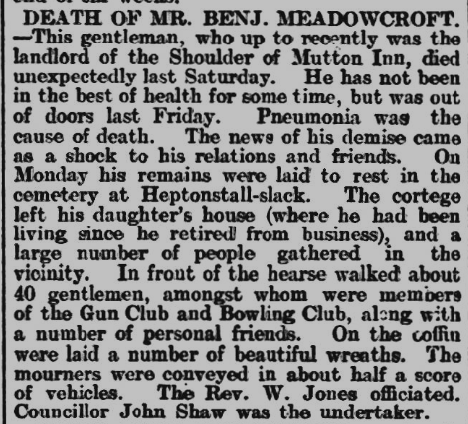
To be continued . . . perhaps I’ll research more members of the Meadowcroft family. It takes me to the Luddenden Valley which was quite magical when I visited this week on a sunny morning. It also gives me a reason to explore further the hillside between Sowerby and Luddenden Foot.
Leave a Reply